Previously on Drokk!: Having stayed on topic for the last 33 episodes, I ended the last installment of Drokk! with a question to esteemed co-host Jeff Lester: did he want to step away from Joe Dredd for a bit and spend an episode reading some Strontium Dog instead? The answer was yes, and so… this.
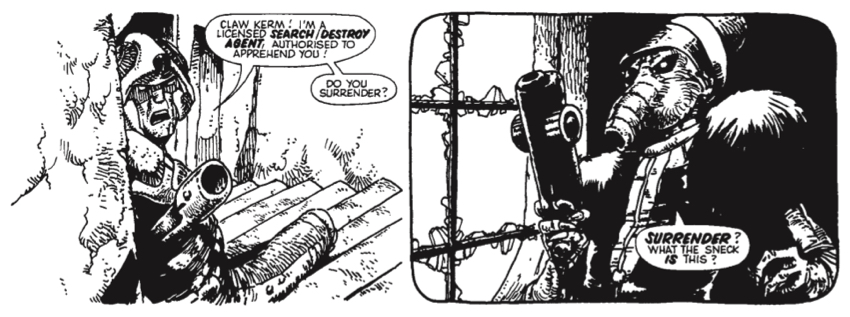
0:00:00-0:09:30: Sure, it’s technically a Drokk!, but at the suggestion of commenter Winty, we’re calling this one Sneck!, because that’s the curse of choice from this particular 2000 AD strip. Anyway, as the episode opens, we introduce the book we’re covering this episode — Strontium Dog: Search/Destroy Agency Files Vol. 2 — as well as the Strontium Dog strip in general, including a suggestion as to how it differs from Dredd despite sharing the same core creators. Indeed, John Wagner and Carlos Ezquerra (and Alan Grant) remained the creative team for the majority of the series’ run, unusually…

0:09:31-1:01:01: Be warned, show notes readers — we’re particularly elliptical on this episode, making straight-forward notation more difficult than usual. (Which, I think we all know, isn’t always the most direct as-is.) Anyway, we talk about a lot, including how the strip fits into both Eurocomics and Spaghetti Western histories; the fact that, even more than Dredd, this strip is a showcase for just how amazing Carlos Ezquerra really is; whether or not a 26-chapter extended flashback that delivers a metric shit-ton of expeditionary world building is the best choice to introduce a new reader to the strip; the ways in which Jeff’s expectations of the strip’s limits were exploded by “The Moses Incident”; how wildly variable the tone of Strontium Dog is, often within the same scene (and why it works, even though it shouldn’t), and whether or not that’s something that connects the strip to Underground Comix, as well as things like Howard the Duck and Cerebus the Aardvark; the ways in which the strip feels just seconds away from going wildly off the rails at seemingly any moment. And there’s even more, as you might expect from almost an hour’s worth of conversation. (We really did go on and on, without any clear demarcation. Sorry?)
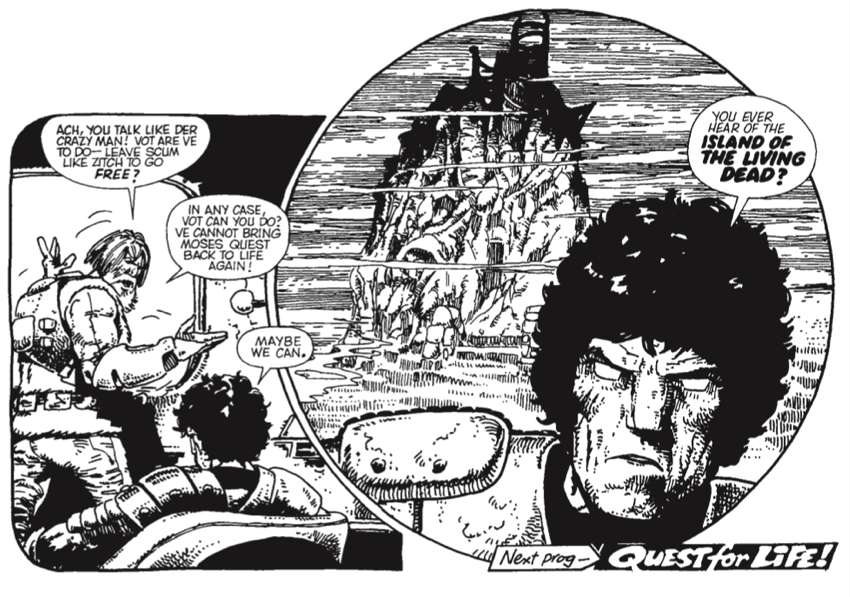
1:01:02-1:17:22: We talk for a little bit about the strip beyond this collection: what happened in subsequent collections, as well as the end and afterlife of the strip and the characters involved. (I say here that Garth Ennis’ Gronk makeover wasn’t done as a gag, which is entirely ungenerous and untrue; my point was that it felt as if the joke was that the Gronk was ridiculous as a coward, not that the makeover was inherently ridiculous in and of itself, but mileage may vary; I don’t like the Gronk, per se, but I still feel like he deserved better.) We also, again, talk about how great Carlos Ezquerra is, because really, his stuff here is amazing. Also covered: Jeff loves Johnny Alpha’s hair; is it easier to grasp the appeal and intent of Strontium Dog than it is Dredd?; Carlos Ezquerra likes to draw the same woman over and over.
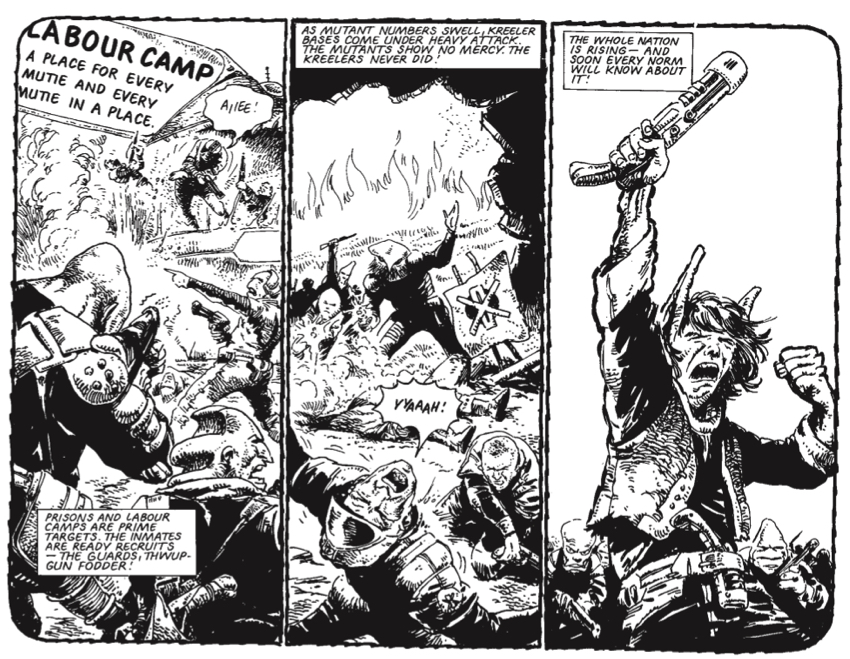
1:17:23-1:33:15: As we start to wrap things up, we talk again about Ezquerra’s brilliance, answer the question about whether or not this volume is a good introduction for new readers (from the point of view of a new reader), and ask ourselves, how should this be adapted into other media? Jeff and I have differing ideas, but since when is that a new thing?
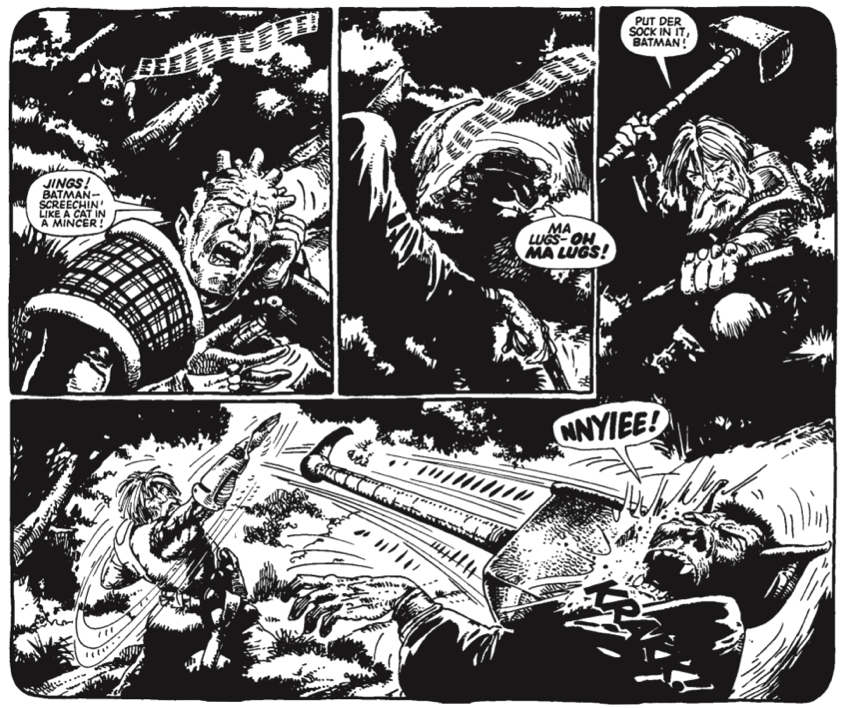
1:33:16-end: We properly bring things to a close by talking a little about what’s ahead for Drokk! and Wait, What? in general before the end of the year. It’s the last proper recording session for the year, so we share our thanks to everyone for listening along with us for the year, and to each other, too. (We don’t share the usual links to Twitter and Patreon, but assume that we do.) Next week: Our favorite books of the year! Next month: Back to Mega-City One! Right now: Thanks for reading along, as ever.
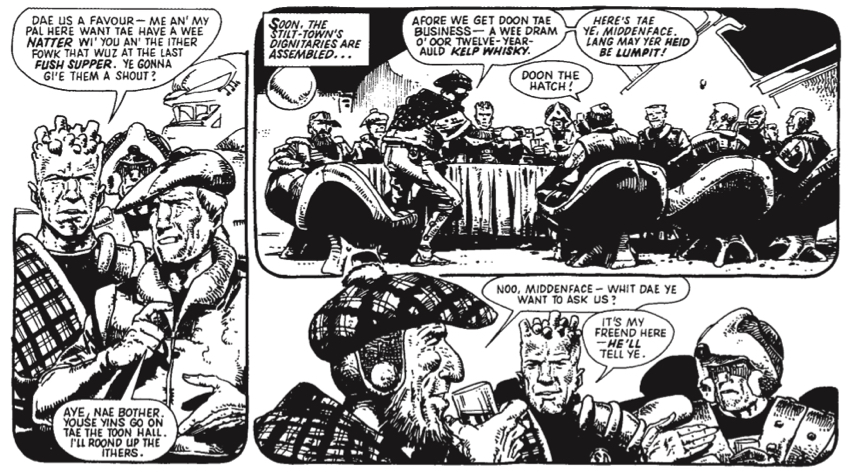


Happy Early Holidays, everyone! Here’s the direct link: https://theworkingdraft.com/media/Drokk/DrokkEp34.mp3
Nice chat. One thing I’ve always felt about SD is that gatherer is a strong gay romance vibe to Wulf and Johnny. Not necessarily conscious from Wagner and Ezquerra but once you see it, hard to unsee. Johnny is certainly dreamier than most of the 2000ad stalwarts of the time (although Rogue Trooper’s chest and shoulders definitely would have turned heads on Nu-Earth. But Johnny and Wulf had a real couple vibe and Hohnny’s torture and Wulf’s death at the hands of Max Bubba have a proper hate crime quality. The late addition of Durham Red with her absurdly buxom and sexy rendition feels like a course correction. A red herring. Anyway I wonder if this slightly romantic tweaking of the tough guy routine may have contributed to the strip’s idiosyncratic flavour.
Yes, I think the gay subtext with Johnny and Wulf, to whatever degree it was intentional, is hard to miss. I think your observation about Durham Red feeling like a timid course “correction” is a sharp one. There’s this turn in 2000 AD in the mid-to-late ‘80s towards no longer being sexless, and instead handling sex in ways designed to appeal to straight teenage boys, which is one of the clumsier responses to the “Comics aren’t just for children!” moment. You can definitely imagine them worrying, unconsciously or consciously, that Johnny was coming across as gay.
And I think in “Max Bubba,” it’s getting fairly explicit, at least by the standards of 2000 AD in the 1980s — aside from the hate crime overtones of Wulf’s death, there’s a strong “these two are a couple” vibe about the opening, with Johnny and Wulf going off on a holiday. (This does unfortunately make “Rage!”, generally such an excellent story, have an aspect to it of an unpleasant trope.) But because early 2000 AD basically didn’t do romance, this ends up with Strontium Dog being the most romantic thing in early 2000 AD.
And I think you’re completely right that the Johnny-Wulf relationship is part of the secret to Strontium Dog. Once Wulf is gone, it never works quite as well. Wagner is good at married couples, and that’s essentially what he’s writing here. Wulf is really important because he’s actually got more depth and nuance to the characterization than Johnny has.
Johnny is a Western or noir archetype: he’s the lone honorable and decent man who inhabits a world that’s immoral and violent, and the stories are about how he plays by the vicious rules of a life that he would never have chosen but sticks to his personal code as a way to preserve his inner moral self despite the part that the world is forcing him to play. And that’s a really good archetype, and the fact that it’s both a Western and a noir thing is part of why Strontium Dog can do the abrupt genre shifts about which our hosts commented — you can plug that basic character into anything, and they (usually a “he”) will work.
(It could be read as code for Wagner — by all accounts a rather decent individual who did things like share money with Pat Mills that he had no legal obligation to share — dealing with the compromises that he had to make working in the British comics industry, which God put on Earth so that there was some comics industry whose practices were worse than the American. It also gives rise to some classic Wagner cynicism about the other Strontium Dogs, and other mutants in general — they often feature as antagonists and are distinguished from Johnny by lacking this basic sense of decency. It’s like the scabrous depictions of couch potatoes during the democracy stories in Judge Dredd — Wagner likes to suggest that the oppressed rarely respond to their oppression by becoming better people because of it.)
But Johnny is an archetype; as our hosts said, there’s not a lot of depth there. Wulf is a lot less obviously an archetype — he’s not an especially complex character, but he’s an individual one in a way that Johnny isn’t. (I think the Viking thing is a retcon, incidentally — it’s not mentioned until his final story, and IIRC there’s at least one textual thing that indicates otherwise. What’s stressed early on is that he’s a “norm” Strontium Dog.)
I’ll stick up for the Gronk, too, against our hosts’ blinkered> and unfair attacks on a beloved piece of childhood whimsy. That’s part of it — the Gronk is a children’s character. He’s a representation of a child himself — physically small, innocent and well-meaning, and, of course, easily frightened. Like Johnny, he’s an archetype (but one that uses that classic 2000 AD trick of making the archetype an alien as a way to make it a caricature). He’s specifically an archetype from British children’s fiction: he’s the child who saves the day and learn that “Being brave isn’t being unafraid; it’s being afraid and doing the right thing anyway.”
It’s a family. Johnny and Wulf are the parents; the Gronk is their child; within that, Johnny is the stereotyped Dad figure (he makes all the decisions, is emotionally distant and repressed in a rather toxic way, but does care about the Gronk) and Wulf is the stereotyped Mum figure (more emotionally available and easy-going, and has the closer relationship with the Gronk, which is to say the child — that Wulf is cast in the feminine role is a nice touch, given that visually he’s this bearded mountain of a man with a big nose).
So the Gronk contributes in an important way to the gay couple aspect of Johnny and Wulf, by making it about a *family.* And this is part of the secret Strontium Dog formula. Because, yes, you can plug that basic Western/noir archetype into anything and it can work — but how often is it plugged into stories about a family? It’s characteristically about the lone decent man in a corrupt world, not one who can retreat into his decent family.
Compare that to the Gronk’s most obvious comparandum, which is Walter the Wobot. Walter plays the same role as the Gronk, in that he’s there to give children something to laugh at in what was originally a children’s adventure comic aimed at boys in primary school. Graeme McMillan said some very solid things early in Drokk! about how ugly and homophobic the Walter-Dredd relationship is. Isn’t the Gronk a much less toxic character?
He’s also got a great visual design, damn you, Jeff Lester and Graeme McMillan.
I like these comments on the SD family. Casting Wulf as the mum fits well with his characterisation as the practical one. Does anyone know if the way Wulf talked about his ‘happy stick’ was a conscious echo of Chung’s ‘click-ba’? Chung was the racist stereotype sidekick of the Wolf of Kabul, who was Red Rascal from Doonesbury played straight for the British Empire.
In the late 90s I drew some pictures for my friend Amanda’s Strontium Dog fanzine, Dogbreath. Always happy for a bit of chat on the subject. I don’t think ‘Sneck’ would have the legs of ‘Drokk’ as a series, though as, at least while Wagner, Grant and Ezquerra are on it, it’s very even in quality. For me it doesn’t have the highs or lows that Dredd has.
I understand the comments regarding the introduction of Durham Red as a probable course correction but this being Wagner and Grant they totally undermine any possible editorial mandates by making the buxom and sexy character have a geordie accent and further support Johnny Alpha’s bi-sexuality by having him oblivious to her feminine whiles for much of the story and then staging a threesome shower scene between the two and Ronnie Reagan (yes, that Ronnie Reagan). Strontium Bitch is one of many of Strontium Dog’s finest hours.
Not mentioned in the comments or during the podcast is the historical context within which Strontium Dog first appeared, which is very much centred around the coming of age in the late 70’s/early 80’s of Thalidomide and Polio children. The later is best exemplified by the musician Ian Dury and his song Spasticus Autisticus which attacked the patronising view of his disability as victimhood, something very much a theme with the mutants in Strontium Dog. The other influence, of course, was the rise in British racism in the 70’s and in particular Enoch Powell, an obvious influence on Nelson Kreelman.
For all the use of spaghetti western archetypes Strontium Dog is a far more British comic strip than Judge Dredd, as exemplified by the aforementioned Durham Red and, of course, Middenface McNulty, which I think would be one of the things lost in any media adaptation,
Finally, while I understand Jeff’s seem-dislike of late era Ezquerra photoshop colouring, he should try and track down the Starlord and Journey into Hell Strontium Dog stories as these are hand coloured by Ezquerra and every bit as atmospheric as the black and white art sown in volume 2.
Great podcast as always, and it makes me want to go back and reread the original stories.
I really enjoyed this episode, despite A) not having read the book, and B) not really liking the character much from the handful of appearances he had in Dredd. As for the former, all I could find was the digital copy, and I wasn’t about to read 400+ pages on my computer. I hope Rebellion reprints it soon, because I’d love to get my hands on that Carlos Ezquerra art. I’m doubly intrigued by Strontium Dog since in the year-end episode Chloe described it as X-Men done right!